check engine light OLDSMOBILE SILHOUETTE 1993 Owners Manual
[x] Cancel search | Manufacturer: OLDSMOBILE, Model Year: 1993, Model line: SILHOUETTE, Model: OLDSMOBILE SILHOUETTE 1993Pages: 323, PDF Size: 17.13 MB
Page 112 of 323
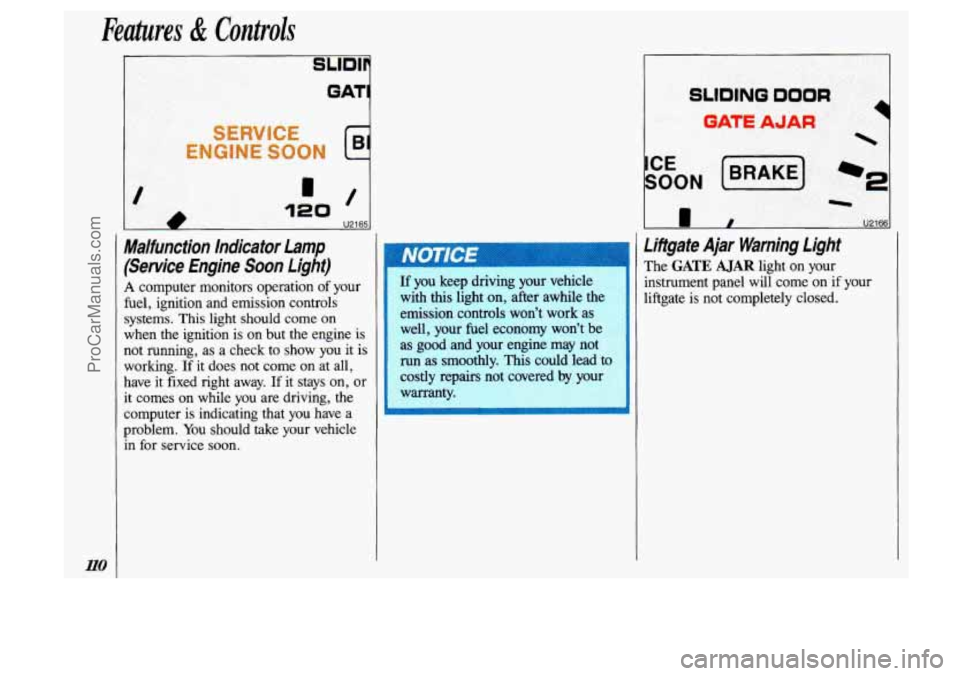
Features & Controls
SLIDIP
GAT1
SERVICE
ENGINE SOON
120 U2165
Malfunction Indicator Lamp
(Service Engine Soon Light)
A computer monitors operation of your
fuel, ignition and emission controls
systems. This light should come
on
when the ignition is on but the engine is
not running, as a check to show you it is
working.
If it does not come on at all,
have it fixed right away.
If it stays on, or
it comes
on while you are driving, the
computer is indicating that
you have a
problem.
You should take your vehicle
in for service
soon.
If you keep driving your vehicle
with this light
on, after awhile the
emission controls won’t work
as
well, your fuel economy won’t be
as good and your engine may not
run as smoothly. This could lead to
costly repairs not covered by you1
warranty.
Lifigate Ajar Warning light
The GATE AJAR light on your
instrument panel will come on if your
liftgate is not completely closed.
ProCarManuals.com
Page 170 of 323
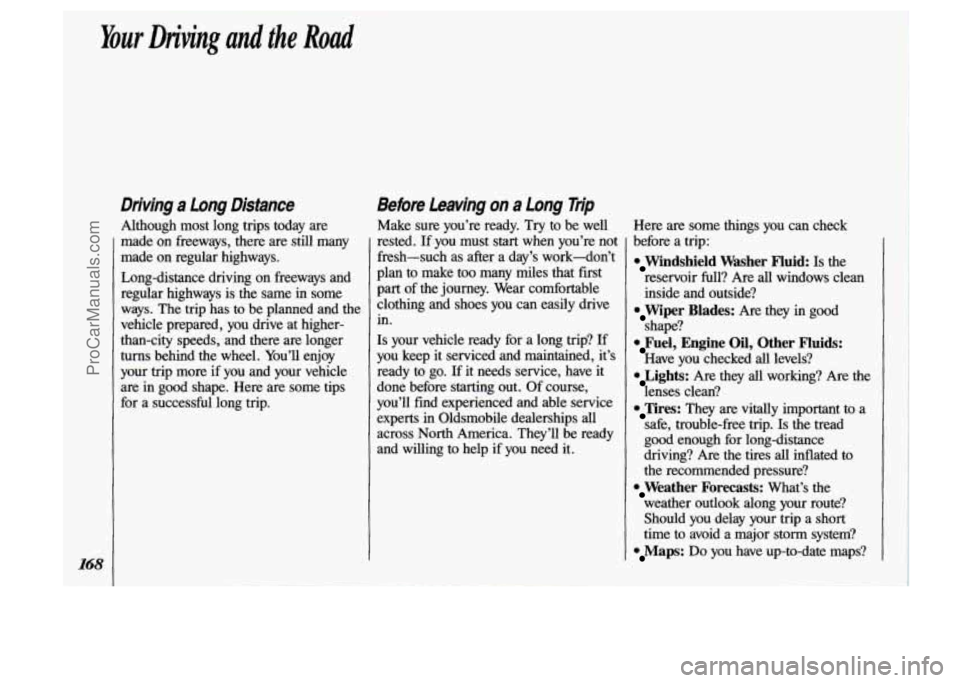
Driving a Long Distance
Although most long trips today are
Before Leaving on a Long Trip
Make sure you’re ready. Try to be well
I
I
I
168
J
7
1
1
-
made on freeways, there are still many
made on regular highways.
Long-distance driving on freeways and regular highways is the same in some
ways. The trip has to be planned and the
vehicle prepared, you drive at higher-
than-city speeds, and there are longer
turns behind the wheel. You’ll enjoy
your trip more if you and your vehicle
are
in good shape. Here are some tips
for a successful long trip. rested.
If you
must start when you’re not
fresh-such as after a day’s work-don’t
plan to make too many miles that first
part of the journey. Wear comfortable
clothing and shoes you can easily drive
in.
Is your vehicle ready for a long trip? If
you keep it serviced and maintained, it’s
ready to go.
If it needs service, have it
done before starting out.
Of course,
you’ll find experienced and able service
experts in Oldsmobile dealerships all across
North America. They’ll be ready
and willing to help
if you need it. Here
are some things you can check
before a trip:
Windshield Washer Fluid: Is the
reservoir full? Are
all windows clean
inside and outside?
Wiper Blades: Are they in good
shape?
Fuel, Engine Oil, Other Fluids:
Have you checked all levels?
Lights: Are they all working? Are the
lenses clean?
Tires: They are vitally important to a
safe, trouble-free trip.
Is the tread
good enough for long-distance
driving? Are the tires
all inflated to
the recommended pressure?
weather outlook along your route? Should you delay your trip a short
time to avoid a major storm system?
Maps: Do you have up-to-date maps?
Weather Forecasts: What’s the
ProCarManuals.com
Page 171 of 323
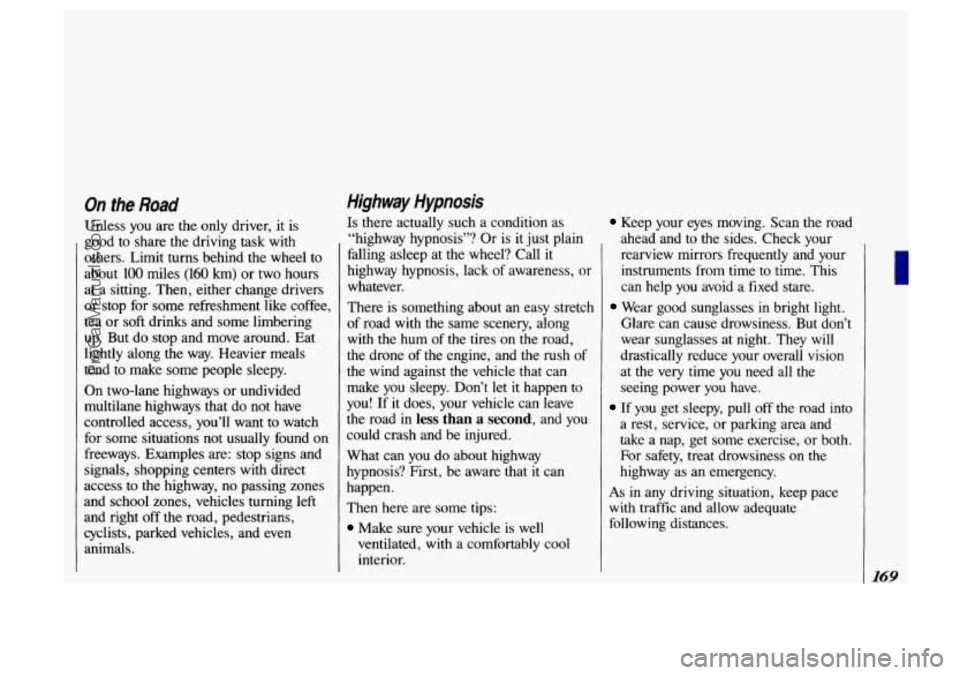
On the Road
Unless you are the only driver, it is
good to share the driving task with
others. Limit turns behind the wheel to
about 100 miles
(160 km) or two hours
at a sitting. Then, either change drivers
or stop for some refreshment like coffee,
tea or
soft drinks and some limbering
up. But do stop and move around. Eat
lightly along the way. Heavier meals
tend to make some people sleepy.
On two-lane highways or undivided
multilane highways that do not have
controlled access, you’ll want to watch
for some situations not usually found on
freeways. Examples are: stop signs and
signals, shopping centers with direct
access to the highway, no passing zones
and school zones, vehicles turning left
and right
off the road, pedestrians,
cyclists, parked vehicles, and even animals.
Highway Hypnosis
Is there actually such a condition as
“highway hypnosis”? Or is it just plain
falling asleep at the wheel? Call it
highway hypnosis, lack
of awareness, or
whatever.
There is something about an easy stretch
of road with the same scenery, along
with the hum of the tires on the road,
the drone of the engine, and the rush
of
the wind against the vehicle that can
make you sleepy. Don’t let
it happen to
you! If it does, your vehicle can leave
the road in
less than a second, and you
could crash and be injured.
What can you do about highway
hypnosis? First, be aware that it can
happen.
Then here are some tips:
Make sure your vehicle is well
ventilated, with a comfortably cool interior.
Keep your eyes moving. Scan the road
ahead and to the sides. Check your
rearview mirrors frequently and your
instruments from time
to time. This
can help
you avoid a fixed stare.
Wear good sunglasses in bright light.
Glare can cause drowsiness. But don’t
wear sunglasses at night. They will
drastically reduce
your overall vision
at the very time you need all the
seeing power you have.
If you get sleepy, pull off the road into
a rest, service,
or parking area and
take a nap, get some exercise, or both.
For safety, treat drowsiness on the
highway as an emergency.
As in any driving situation, keep pace
with traffic and allow adequate following distances.
169
ProCarManuals.com
Page 183 of 323
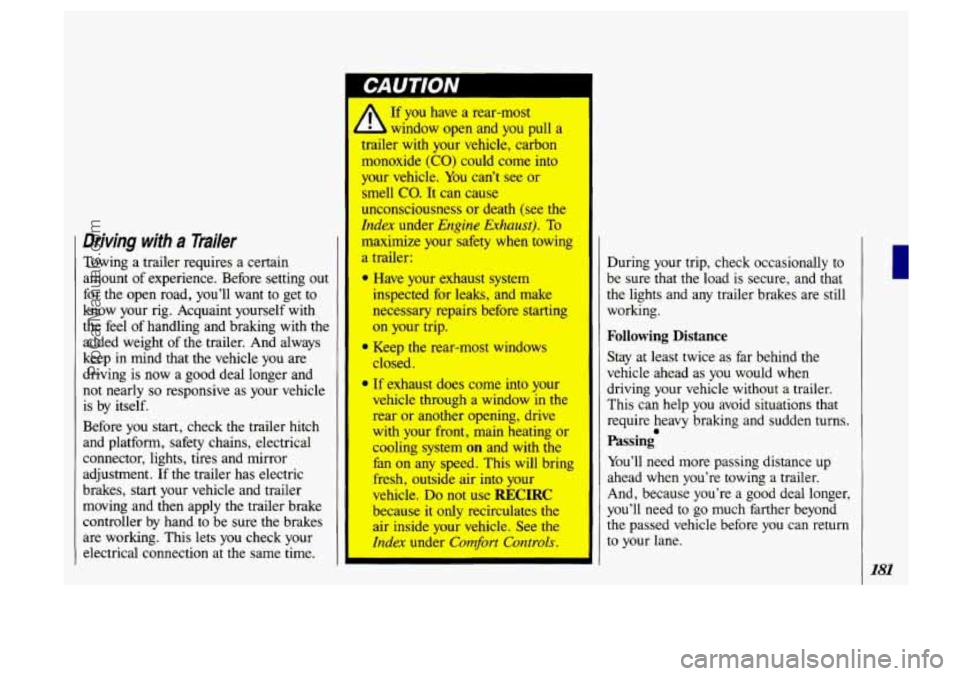
1 Driving with a Trailer
Towing a trailer requires a certain
amount of experience. Before setting out
for the open road, you’ll want to get
to
know your rig. Acquaint yourself with
the feel of handling and braking with the
added weight of the trailer. And always
keep in mind that the vehicle you are
driving is now a good deal longer and
not nearly
so responsive as your vehicle
is by itself.
Before you start, check the trailer hitch
and platform, safety chains, electrical
connector, lights, tires and mirror
adjustment.
If the trailer has electric
brakes,
start your vehicle and trailer
moving and then apply the trailer brake
controller by hand to be sure the brakes
are working. This lets you check your
electrical connection at the same time.
If you have a rear-most
window open and you pull a
mler with your‘vehicle, carbon
monoxide (CO) could come into
your vehicle. You can’t see or
smell CO. It can cause
unconsciousness or death (see the
Inh under Engine Exhausb). To I
maximize your safety when towing
a trailer:
@ Have your exhaust system
inspected for leaks, and Make
necessary yirs before starting
on your trip.
closed.
If exhaust does corne into your
vehicle through a window in the
fear or another opening, drive
with your front, main heating or
cmling system on and with the
fan on any speed. This WU bring
fresh, outside air into your
vehicle.
Do not use RECIRC
because it only recirculates the
air imide ywr vehick, See the
Index under Comfort &m&.
e KWP the =-most windows
During your trip, check occasionally to
be sure that the load is secure, and that
the lights and any trailer brakes are still
working.
Following Distance
Stay at least twice as far behind the
vehicle ahead as you would when
driving your vehicle without a trailer.
This can help you avoid situations that
require heavy braking and sudden turns.
Passing
You’ll need more passing distance up
ahead when you’re towing a trailer.
And, because you’re a good deal longer,
you’ll need to go much farther beyond
the passed vehicle before you can return
to your lane.
0
ProCarManuals.com
Page 184 of 323
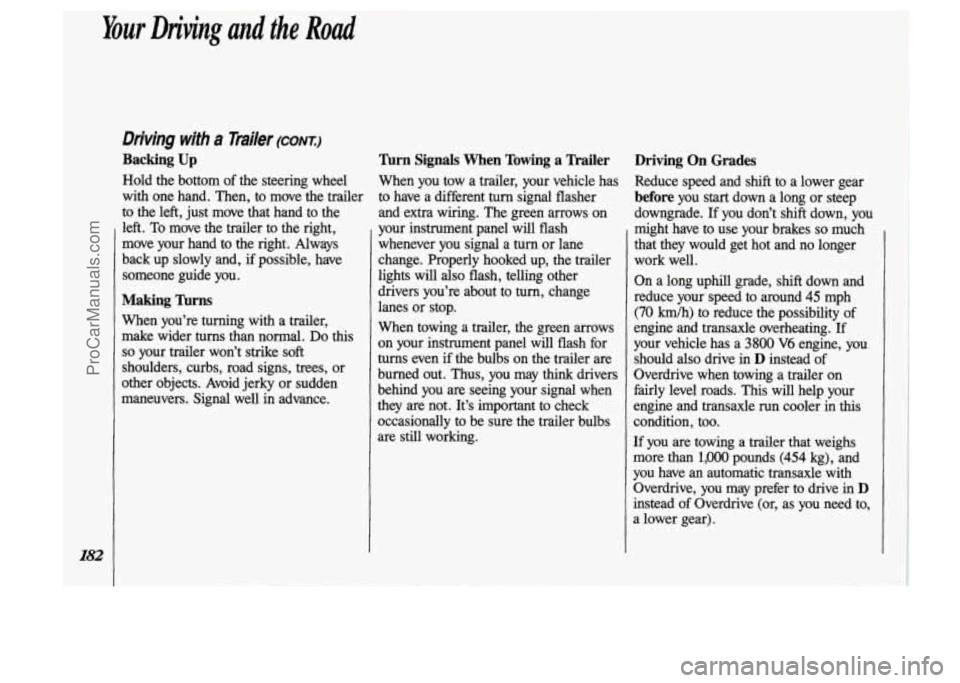
Your Driving and the Road
Driving with a Trailer (CONT.)
Backing Up
Hold the bottom of the steering wheel
with one hand. Then, to move the trailer
to the left, just move that hand
to the
left. To move the trailer to the right,
move your hand to the right. Always
back up slowly and, if possible, have
someone guide you.
Making Turns
When you’re turning with a trailer,
make wider
turns than normal. Do this
so your trailer won’t strike soft
shoulders, curbs, road signs, trees, or
other objects. Avoid jerky or sudden
maneuvers. Signal well in advance.
Turn Signals When Towing a Trailer
When you tow a trailer, your vehicle has
to have a different
turn signal flasher
and extra wiring. The green arrows on
your instrument panel will flash
whenever you signal
a turn or lane
change. Properly hooked up, the trailer
lights will also flash, telling other
drivers you’re about to
turn, change
lanes or stop.
When towing a trailer, the green arrows
on your instrument panel will flash for
turns even if the bulbs on the trailer are
burned out. Thus, you may think drivers
behind you are seeing your signal when
they are not. It’s important to check
occasionally to be sure the trailer bulbs
are still working.
Driving On Grades
Reduce speed and shift to a lower gear
before you start down a long or steep
downgrade.
If you don’t shift down, you
might have to use your brakes
so much
that they would get hot and no longer
work well.
On a long uphill grade,
shift down and
reduce your speed to around
45 mph
(70 Wh) to reduce the possibility of
engine and transaxle overheating. If
your vehicle has a 3800 V6 engine, you
should also drive in
D instead of
Overdrive when towing a trailer on
fairly level roads. This will help your
engine and transaxle run cooler in
this
condition, too.
If you are towing a trailer that weighs
more
than 1,000 pounds (454 kg), and
you have an automatic transaxle with Overdrive, you may prefer to drive in
D
instead of Overdrive (or, as you need to,
a lower gear).
ProCarManuals.com
Page 191 of 323
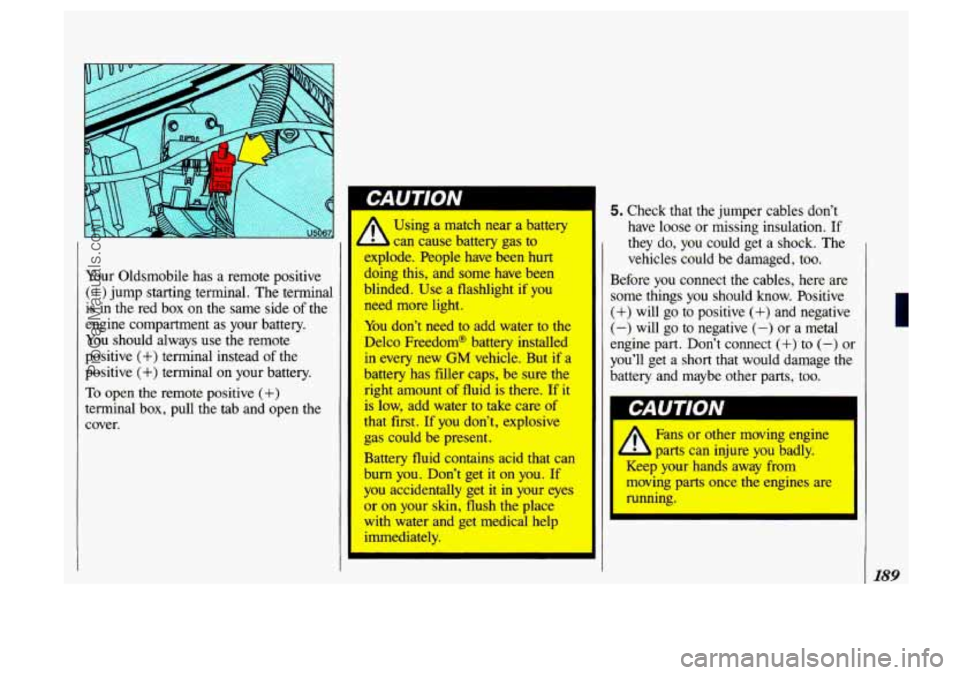
Your Oldsmobile has a remote positive
(+) jump starting terminal. The terminal
is in the red box on the same side
of the
engine compartment as your battery.
You should always use the remote
positive
(+) terminal instead of the
positive
(+) terminal on your battery.
To open the remote positive (+)
terminal box, pull the tab and open the
cover.
A
Using a match near a battery
can cause battery gas to
explode. People have been
hurt
doing this, and some have been
blinded. Use a flashlight if you
need more light.
You don’t need to add water to the
Delco Freedom@ battery installed
in every new
GM vehicle. But if a
battery has filler caps, be sure the
right amount of fluid is there. If
it
is low, add water to take care of
that first. If you don’t, explosive
gas could be present.
Battery fluid contains acid that can
bum you. Don’t get it on
you. If
you accidentally get it in your eyes
or
on your skin, flush the place
with water and get medical help
immediately.
5. Check that the jumper cables don’t
have loose or missing insulation. If
they do, you could get a shock. The
vehicles could be damaged, too.
Before you connect the cables, here are
some things you should know. Positive
(+) will go to positive (+) and negative
(-) will go to negative (-) or a metal
engine part. Don’t connect
(+) to (-) or
you’ll get a short that would damage the
battery and maybe other parts, too.
Fans
or other moving engine
parts can injure you badly.
Keep your hands away bm
moving parts once the engines are
running. I
I89
ProCarManuals.com
Page 227 of 323
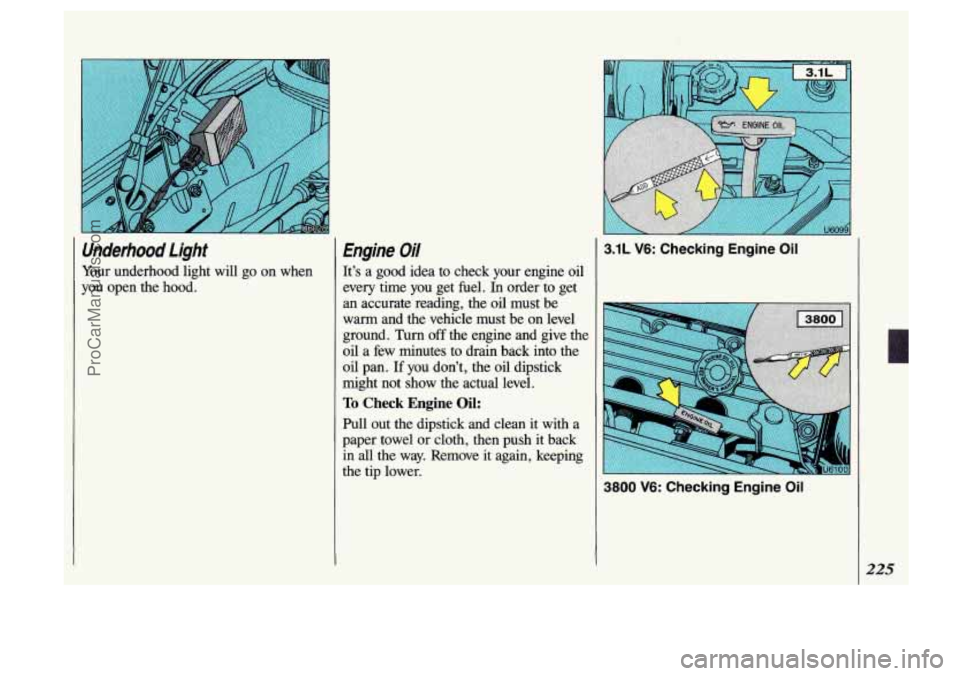
Underhood Light
Your underhood light will go on when
you open the hood.
Engine Oil
It’s a good idea to check your engine oil
every time you get fuel. In order to get
an accurate reading, the oil must be
warm and the vehicle must be on level
ground.
Turn off the engine and give the
oil a few minutes to drain back into the
oil pan. If you don’t, the oil dipstick
might not show the actual level.
To Check Engine Oil:
Pull out the dipstick and clean it with a
paper towel or cloth, then push it back
in
all the way. Remove it again, keeping
the tip lower.
I 3.1L V6: Checking Engine Oil
3800 V6: Checking Engine Oil
225
ProCarManuals.com
Page 270 of 323
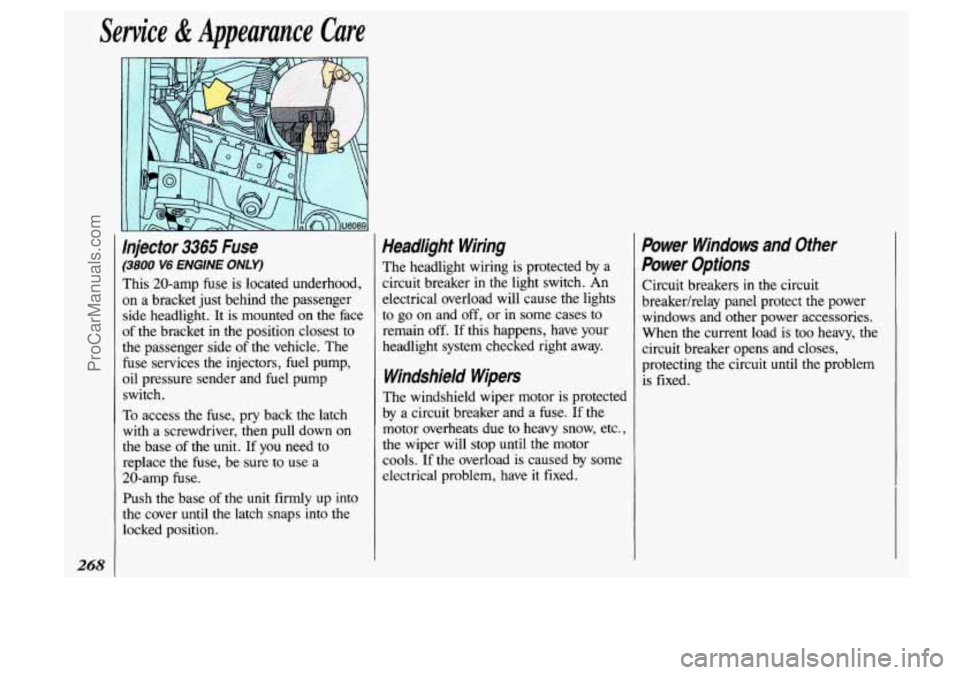
Service & Appearance Care
268
/njector 3365 Fuse
(3800 V6 ENGINE ONLY)
This 20-amp fuse is located underhood,
on a bracket just behind the passenger
side headlight.
It is mounted on the face
of the bracket in the position closest to
the passenger side of the vehicle. The
fuse services the injectors, fuel pump,
oil pressure sender and fuel pump
switch.
To access the fuse, pry back the latch
with a screwdriver,
then pull down on
the base of the unit. If you need to
replace the fuse, be sure to use a
20-amp fuse.
Push the base of the unit
firmly up into
the cover until
the latch snaps into the
locked position.
Head/ight Wiring
The headlight wiring is protected by a
circuit breaker in the light switch. An
electrical overload will cause the lights
to go on and off, or in some cases to
remain off.
If this happens, have your
headlight system checked right away.
Windshield Wipers
The windshield wiper motor is protected
by a circuit breaker and
a fuse. If the
motor overheats due to heavy snow, etc.
,
the wiper will stop until the motor
cools. If the overload is caused by some
electrical problem, have it fixed.
Power Windows and Other
Power Options
Circuit breakers in the circuit
breakerhelay panel protect the power
windows and other power accessories.
When the current load is too heavy, the
circuit breaker opens and closes,
protecting the circuit until the problem
is fixed.
ProCarManuals.com
Page 292 of 323
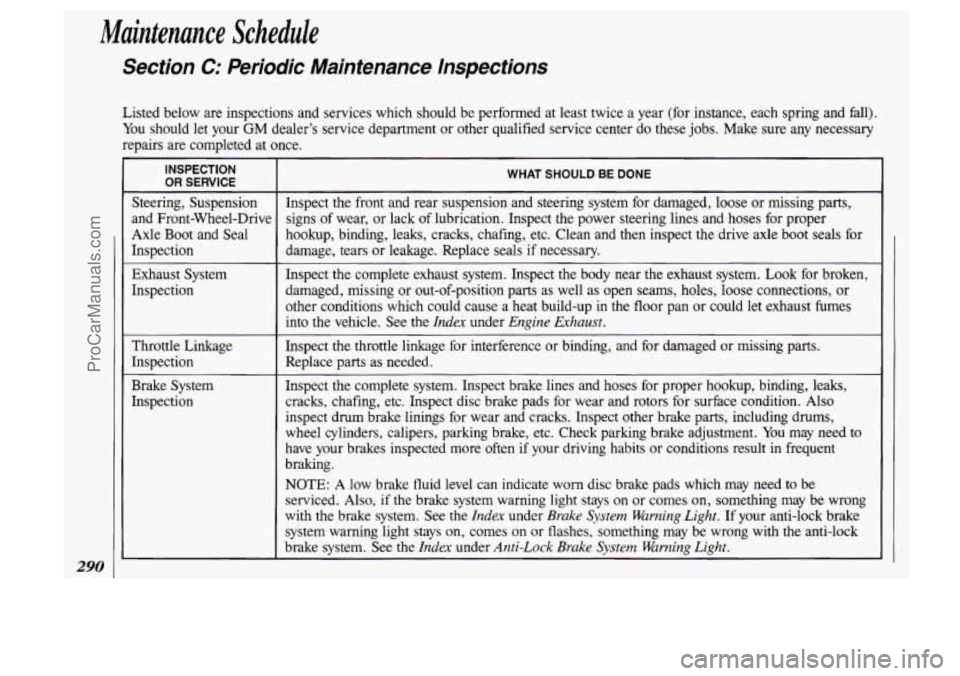
Maintenance Schedule
Section C: Periodic Maintenance lnspections
Listed below are inspections and services which should be performed at least twice a year (for instance, each spring and fall).
You should let your GM dealer’s service department or other qualified service center do these jobs. Make sure any necessary
repairs are completed at once.
290
INSPECTION
OR SERVICE
Steering, Suspension
and Front-Wheel-Drive
Axle Boot and Seal
Inspection
Exhaust System
Inspection
Throttle Linkage
Inspection
Brake System
Inspection
WHAT SHOULD BE DONE
Inspect the front and rear suspension and steering system for damaged, loose or missing parts,
signs of wear, or lack of lubrication. Inspect the power steering lines and hoses for proper
hookup, binding, leaks, cracks, chafing, etc. Clean and then in\
spect the drive axle boot seals for
damage, tears or leakage. Replace seals if necessary.
Inspect the complete exhaust system. Inspect the body near the exhaust system. Look for broken,
damaged, missing or out-of-position parts as well as open seams, holes, loose connections, or
other conditions which could cause a heat build-up in the floor pan or could let exhaust fumes
into the vehicle. See the
Index under Engine Exhaust.
Inspect the throttle linkage for interference or binding, and for damaged or missing parts.
Replace parts as needed.
Inspect the complete system. Inspect brake lines and hoses for \
proper hookup, binding, leaks,
cracks, chafing, etc. Inspect disc brake pads for wear and rotors for surface condition. Also
inspect drum brake linings for wear and cracks. Inspect other brake parts, including drums,
wheel cylinders, calipers, parking brake, etc. Check parking brake adjustment.
You may need to
have your brakes inspected more often
if your driving habits or conditions result in frequent
braking.
NOTE: A low brake fluid level can indicate worn disc brake pads which may need to be
serviced. Also, if the brake system warning light stays on or comes on, something may be wrong
with the brake system.
See the Index under Brake System Warning Light. If your anti-lock brake
system warning light stays on, comes on or flashes, something may be wrong with the anti-lock
brake system. See the
Index under Anti-Lock Brake System Warning Light.
ProCarManuals.com
Page 313 of 323
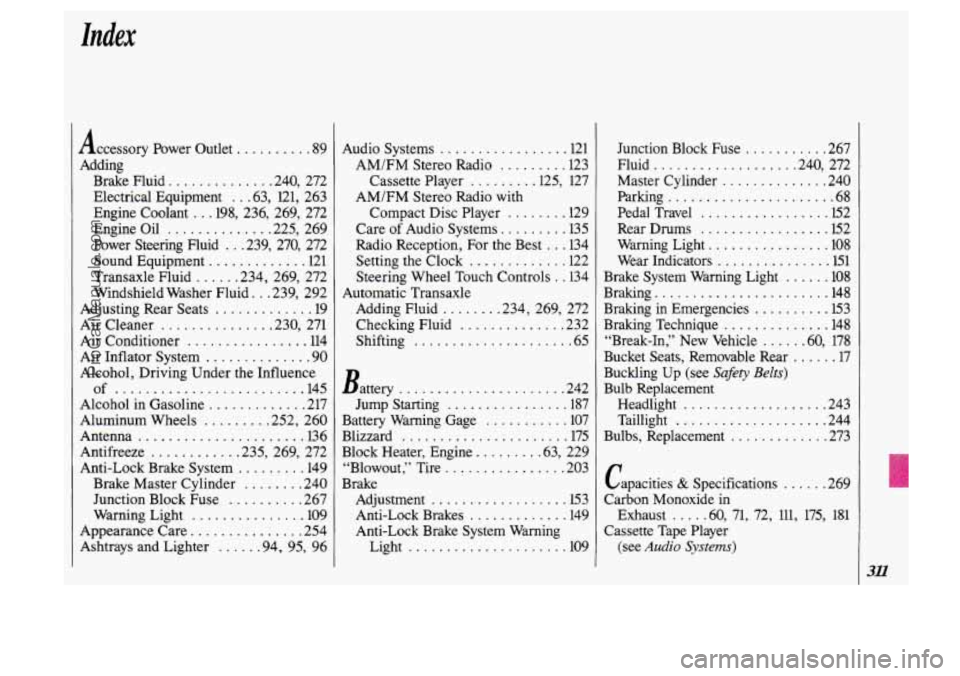
Index
Accessory Power Outlet .......... 89
Adding Brake Fluid
............. .240. 272
Engine Coolant
.. .198. 236. 269. 272
Engine Oil
............. .225. 269
Power Steering Fluid
.. .239. 270. 272
Sound Equipment
............. 121
Transaxle Fluid
..... .234. 269. 272
Adjusting Rear Seats
............. 19
Air Cleaner
.............. .230. 271
Air Conditioner
................ 114
Air Inflator System
.............. 90
Alcohol. Driving Under the Influence
of ......................... 145
Alcohol in Gasoline
............. 217
Aluminum Wheels
........ .252. 260
Antenna
...................... 136
Antifreeze
........... .235. 269. 272
Anti-Lock Brake System
......... 149
Brake Master Cylinder
........ 240
Junction Block Fuse
.......... 267
Warning Light
............... 109
Appearance Care ............... 254
Ashtrays and Lighter
..... .94. 95. 96
Electrical Equipment
.. .63.
121. 263
Windshield Washer Fluid
.. .239. 292 Audio Systems
................. 121
AM/FM Stereo Radio
......... 123
Cassette Player
........ .125. 127
AM/FM Stereo Radio with
Compact Disc Player
........ 129
Care of Audio Systems
......... 135
Radio Reception. For the Best
... 134
Setting the Clock
............. 122
Steering Wheel Touch Controls
. . 134
Adding Fluid
....... .234. 269. 272
Checking Fluid
.............. 232
Shifting
..................... 65
Automatic Transaxle
Battery
...................... 242
Jump Starting
................ 187
Battery Warning Gage
........... 107
Blizzard
...................... 175
Block Heater. Engine ........ .63. 229
“Blowout
,” Tire ................ 203
Brake Adjustment
.................. 153
Anti-Lock Brakes
............. 149
Anti-Lock Brake System Warning Light
..................... 109 Junction Block
Fuse
........... 267
Fluid
.................. .240. 272
Master Cylinder
.............. 240
Parking
..................... -68
Pedal Travel
................. 152
Rear Drums
................. 152
Warning Light
................ 108
Wear Indicators
............... 151
Brake System Warning Light
...... 108
Braking
....................... 148
Braking in Emergencies
.......... 153
Braking Technique .............. 148
“Break-In,” New Vehicle
..... .60, 178
Bucket Seats, Removable Rear
...... 17
Buckling Up (see Safety Belts)
Bulb Replacement
Headlight
................... 243
Taillight
.................... 244
Bulbs, Replacement
............. 273
Capacities
& Specifications ...... 269
Carbon Monoxide in
Cassette Tape Player Exhaust
.... .60, 71, 72,
111, 175, 181
(see
Audio Systems)
311
ProCarManuals.com